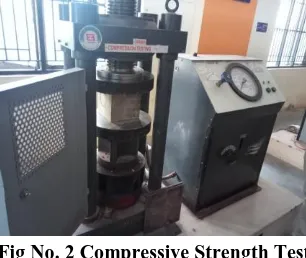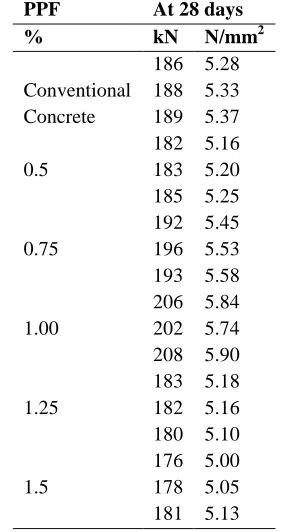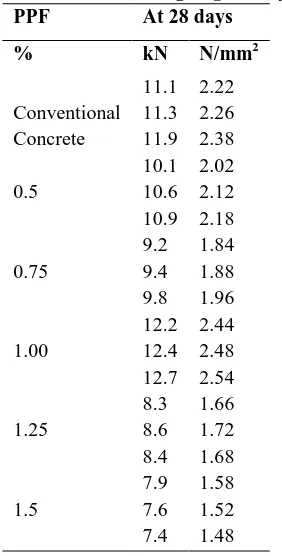Volume-7 Issue-2
International Journal of Intellectual Advancements
and Research in Engineering Computations
Experimental investigation on influence of polypropylene fiber on strength
parameter of concrete
K. L. Ravisankar
1, R. Latha
2, T. K. Mohamed Yousuf Kamil
2, A.Alfan
2&
B. Sivaprakash
21
Assistant Professor, Department of Civil Engineering, Nandha Engineering College, Tamilnadu, India
2
BE -Final Year, Department of Civil Engineering, Nandha Engineering College, Tamilnadu, India
ABSTRACT
The paper deals with the Experimental Investigation on Influence of Polypropylene Fiber on Strength parameter of concrete (M40). Conventional concrete has two major drawbacks low tensile strength and brittle failure. Fiber reinforced concrete (FRC) is concrete containing fibrous material which increases its structural integrity. In an attempt to increase concrete ductility and energy absorption. Polypropylene fiber is a light weight synthetic material. It prevents crack formation and provides reinforced to the concrete structure. An experimental investigation explored properties such as compressive strength, flexural strength, spilt tensile strength and shear strength of polypropylene fiber reinforced concrete. Polypropylene fiber with 12mm length and five volume fractions of 0%, 0.5%, 0.75%, 1%, 1.25%, 1.5% are used.
Keywords: Polypropylene fiber, Workability, Compressive strength, Flexural strength, Spilt tensile strength.
INTRODUCTION
Concrete is most widely used in the world. Because of ability to get cast in any form and shape. Concrete has better resistance in compression while steel has more resistance in tension. Conventional concrete has limited ductility, low impact and abrasion resistance and little resistance to cracking. Micro cracks are formed due to the variation in temperature, shrinkage and heavy moving loads. Hence, alternative composite materials are used in the conventional concrete,the composite materials such as Polypropylene fibre and super plasticizer. The presence of micro cracks at the mortar-aggregate interface is responsible for the inherent weakness of conventional concrete. The weakness can be removed by inclusion of fiber. This type of fibre concrete is known as “Polypropylene fiber reinforced concrete.”
LITERATURE REVIEW
Kolli.ramujee (2015) [5]
The interest in the use of fibers for the reinforcement of composites has increased during the last several years. A combination of high strength, stiffness and thermal resistance favorably characterizes the fibers. In this study, the results of the strength of properties of polypropylene reinforced concrete have been presented. The compressive strength, spilt tensile strength of concrete samples made with different fibers amount varies from 0%, 0.5%, 1%, 1.5% and 2% were studied. The samples with added polypropylene fibers of 1.5% showed better results in comparison with the others.
Milind v. Mohod (2015) [10]
addition of various proportions of polypropylene fibre's on the properties of high strength concrete (M30 and M40).An experimental program carried out to explore its effects on compressive, tensile, flexural strength under different curing conditions. In this study polypropylene fiber mix by varying content such as 0%,0.5%,1%,1.5% and 2%.In this study 1.5% shows better results.
Aminuddinjameran.et.al (2015)
This study, steel fiber and propylene is used to achieve the objectives of the study. Polypropylene fiber significantly decrease the plastic shrinkage cracking as well as drying shrinkage cracking, while steel fiber approximately doubled the energy absorption capacity of the unheated concrete. Most of the literature reviews showed that the use of fiber in concrete can significantly improve the concrete resistance. It shows better results in 1.5% to 2% of fiber.
Gonzalo Martinez-Barrera.et.al. (2011) [2]
Investigated the mechanical properties of polypropylene-fiber reinforced concrete after gamma radiation.By using gamma radiation we have further improved mechanical properties of hydraulic concrete elaborated with Portland cement, water, silica sand, marble and
polypropylene fiber. The fibers so obtained were mixed into the concrete at 0, 1, 1.5 or 2% by volume.
Serkantapkin .et.al (2007) [4]
In this paper shown that the addition of polypropylene considerably alerts the behaviour of conventional concrete. When the polypropylene fiber content increase the Marshall Stability index has been observed. While using the polypropylene percentage is 1% and it gives better results.
OBJECTIVE OF STUDY
The main objective is to study the effects of polypropylene fiber in concrete
To conduct a compressive study on fiber in concrete and conventional concrete.
To reduce the micro cracks on concrete.
Polypropylene fiber
Polypropylene is a type of thermoplastic polymer resin. Polypropylene fibers synthetic fiber obtained as a byproduct from textile industry. The chemical designation is C3H6. There are four general types of fibers currently available in the market. There are steel fiber, polypropylene fiber, glass fiber and carbon fiber.
Fig.No. 1 Polypropylene Fiber
Arrest drying shrinkage
Suitable for pumped concrete and shotcreting
Application of polypropylene fiber
Polypropylene is a light weight fiber It is highly resistant to acid and alkalis Its color does not fade
Plain concrete and wall plastering Used in footing, foundations and tanks
Specification of polypropylene fiber
S.NO SPECIFICATION PROPERTIES 1 Diameter 33-35 microns
2 Cut length 12mm
3 Width crossing Circular 4 Specific gravity 0.91 gr/cm3 5 Melting point 2500C
6 Elongation 45-55%
7 Water absorption 0
METHODOLOGY
Methodology
Title selection
Literature Collection
Literature Study
Material Collection
Testing of Physical properties
Mix design for M40 grade
Fresh Concrete Test
Casting of specimen
Conventional 0.5% 0.75% 1% 1.25% 1.5%
Harden Concrete Test
Report preparation
MATERIAL PROPERTIES
S.No Test Values Obtained
1 Specific gravity of cement 3.14 2 Specific gravity of Fine aggregate 2.6 3 Specific gravity of Coarse aggregate 2.6
4 Water absorption 0.5%
MIX DESIGN
Theconcretemix design has been carried out for various proportions as per ratio and arrived at final mix proportion used for combining the initial
materials.After mixing the polypropylene fiber. The dosages of fiber were0%, 0.5%, 0.75%, 1%, 1.25%, 1.5%.
S.No Materials Units
1 Water 140lit
2 Cement 350kg/m3
3 Coarse aggregate 697 kg/m3 4 Fine aggregate 1238 kg/m3 5 Water cement ratio 0.4
EXPERIMENTAL INVESTIGATION
Test procedure
Concrete test specimens consists of 150x150x150mm cubes, cylinder of 150mm (diameter) and 300mm (height), prism of 100x100x50mm and 300x300x100mm beams. Concrete specimens were tested at 7 days and 28 days obtain the strength of concrete.
Teston Fresh Concrete
The workability of fresh concrete mix is mainly determined to suit the type of construction .Workability is one of the physical parameters of concrete. Concrete is said to be workable when it’s easily placed and compacted. The test for compressive strength on cube is measured at 7 days homogeneously i.e. without segregation. The workability of a concrete is measured by compaction factor test and slump test.
Test on fresh concrete
The test were performed to determine the mechanical properties of control and fiber
reinforced concrete using polypropylene fiber under compression, flexural, and spilt tensile. Measured for polypropylene fiber 0% to 1.5% by weight of cement. The test for compressive strength on cube is measured at 7 days and 28 days of curing. The test for flexural strength on prism is measured at 7 days and 28 days of curing. The test for spilt tensile strength on cylinder is measured at 7 days and 28 days of curing.
Compressive strength
The important property of concrete is its strength in compression. The aim of this experimental test is to determine the maximum load carrying capacity of the specimen. The cubes of sizes are 150mm x150mm x 150mm was cast. Three numbers of specimens were tested for 7 days and 28 days. The specimens are casted for M40
Fig No. 2 Compressive Strength Test
Table : Compressive Strength of Cube specimen @ 7 & 28 days
PPF At 7 days At 28 days
% kN N/mm2 kN N/mm2
Conventional Concrete
800 35.11 920 40.88 840 37.33 930 41.33 870 38.66 940 41.77 0.5 750 33.33 950 42.22
790 35.11 960 42.66 820 36.44 970 43.11 0.75 840 37.33 980 43.55
850 37.77 990 44.00 870 38.66 1000 44.44
1.00
880 39.11 1050 46.66 890 39.55 1070 47.55 900 40.00 1100 48.88
1.25
590 26.22 740 32.88 570 25.33 790 35.11 580 25.78 780 34.66
1.5
510 22.67 740 33.00 500 22.22 720 32.00 490 21.78 700 31.11
0 10 20 30 40 50 60
conv 0.5 0.75 1 1.25 1.5
7days
Spilt tensile strength
Cylinders of size 150mm diameters and 300mm height were cast. Three numbers of specimens were tested for 7 days and 28 days. The specimens
are casted for M40 Grade with different proportions
of polypropylene fiber concrete with different proportions of polypropylene fiber.
Fig No. 3 Split Tensile Test
Table : Split Tensile Strength @ 28 days
PPF At 28 days
% kN N/mm2
Conventional Concrete
186 5.28 188 5.33 189 5.37
0.5
182 5.16 183 5.20 185 5.25
0.75
192 5.45 196 5.53 193 5.58
1.00
206 5.84 202 5.74 208 5.90
1.25
183 5.18 182 5.16 180 5.10
1.5
Flexural strength
Prism size of 100mm x 100mm x 500mm was cast. Three numbers of specimens were tested for 7
days and 28 days. The specimens are casted for M40 Grade concrete.
Fig No. 4 Flexural strength test
Table : Flexural Strength @ 28 days
PPF At 28 days
% kN N/mm2
Conventional Concrete
11.1 2.22 11.3 2.26 11.9 2.38
0.5
10.1 2.02 10.6 2.12 10.9 2.18
0.75
9.2 1.84 9.4 1.88 9.8 1.96
1.00
12.2 2.44 12.4 2.48 12.7 2.54
1.25
8.3 1.66 8.6 1.72 8.4 1.68
1.5
7.9 1.58 7.6 1.52 7.4 1.48
4.5 5 5.5 6
conv 0.5 0.75 1 1.25 1.5
28days
CONCLUSION
The use of polypropylene fibers has increased in recent years due to the property of the fibers to eliminate some defects in concrete. The addition of polypropylene fibers to concrete improves its mechanical properties.
It is observed from the fig 2 that the cube compressive strength increased upto 1% fiber content
It is observed from fig 3 that the spilt tensile strength was increased upto 1 % fiber content It is observed from fig 4 that the prism flexural
strength was increased upto 1 % fiber content
REFERENCES
[1]. Chenon-Goo Hana, Yin-SeongHwanga, Seong-Hawn Yangb, N.Gowripalane, “Performance of Spalling Resistance of High Performance concrete with Poly propylene Fiber Content and lateral confinement” in Cement and Concrete Research 305, 2005, 1747-1753
[2]. Gonzalo Martinez-Berrera, Fernando Urena-nunez, Osman Gencel, WitoldBrostow, “Mechanical Properties FiberReinforced Concrete After Gamma Irradiation” Composite: Part A 42, 2011, 567-572
[3]. Alhozaimy A.M,, and Soroushaiad p., “Mechanical Properties of Reinforced Concrete and Materials Polypropylene Fiber the Effects of Pozzolanic”, Cement & Concrete Composites, 18, 1996, 85-92.
[4]. SerkanTapkin,. “The effect of polypropylene fibers on asphalt performance”, Building and Environment, 2007, 1065-1071.
[5]. Kolli. Ramujee “Strength properties of polypropylene fiber reinforced concrete” International Journal of Innovative Research in Advanced Engineering [IJIRAE] 2(8), 2013.
[6]. Archana p, “Study of strength of polypropylene fiber reinforced concrete” International Journal of Reasearch and Technology 6(6), 2017.
[7]. Murahari k and R. Rao “Effects of polypropylene fibers on the strength properties of fly ash based concrete” [8]. Divya S Dharan and AswathyLal “Study the effect of polypropylene fiber in concrete” International
ReasearchJournal of Engineering and Technology (IRJET) 3(6), 2016.
[9]. Amsa M and Ariyannan P, “Experimental Study on Polypropylene fiber reinforced concrete”. International Reasearch Journal of Engineering and Technology (IRJET) 5(4), 2018.
[10].Milind V. Mohod “Performance of polypropylene fiber reinforced concrete”. IOSR Journal of Mechanical and Civil Engineering (IOSR-JMCE), 12(1), 2015.
0 0.5 1 1.5 2 2.5 3
conv 0.5 0.75 1 1.25 1.5


